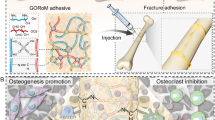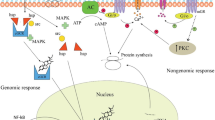Abstract
Background
Extensive research has implicated inflammation as a necessary and causative factor in the development of peri-implant osteolysis, suggesting that such an inflammatory response is the sentinel event for the process. The potential to impact the clinical course of this condition is hampered by the lack of an effective medical therapy, as well as a limited ability for early detection prior to radiographically evident osteolysis. Advances in nanotechnology have allowed for the production of engineered water-soluble nanocarriers, which exploit changes in the microvascular architecture for selective distribution to inflamed tissues. Evaluation of the uptake of the nanocarriers in sites of inflammation has elucidated a novel mechanism of cellular uptake and retention of these particles.
Purpose
The current review discusses the development of a novel, biocompatible, water-soluble nanocarrier utilizing copolymers of N-(2-hydroxypropyl)methacrylamide (HPMA), conjugated to imaging and therapeutic agents for the detection and targeted treatment of inflammatory conditions.
Methods
We performed Medline searches for the terms “periprosthetic osteolysis,” “murine osteolysis model,” “HPMA osteolysis,” and “HPMA inflammation.” These searches identified 631, 306, 1, and 6 articles, respectively. These were then manually searched for articles relevant to the development of mouse models for inflammatory osteolysis and the use of HPMA copolymer technology in mouse models of inflammation.
Results
Promising results in a small animal model of osteolysis have demonstrated the capability for detection prior to the development of bone loss, and have highlighted the utility of nanocarriers for selective drug delivery to the affected tissues.
Conclusions
Challenges to the clinical translation of HPMA nanocarriers in peri-implant osteolysis remain, and the future research directions necessary for human clinical application are reviewed.




Similar content being viewed by others
References
Bozic KJ, Kurtz SM, Lau E, Ong K, Vail TP, Berry DJ. The epidemiology of revision total hip arthroplasty in the United States. J Bone Joint Surg Am. 2009;91(1):128–33. doi:10.2106/JBJS.H.00155.
Caicedo MS, Desai R, McAllister K, Reddy A, Jacobs JJ, Hallab NJ. Soluble and particulate Co-Cr-Mo alloy implant metals activate the inflammasome danger signaling pathway in human macrophages: a novel mechanism for implant debris reactivity. J Orthop Res. 2009;27(7):847–54. doi:10.1002/jor.20826.
Clohisy JC, Hirayama T, Frazier E, Han SK, Abu-Amer Y. NF-kB signaling blockade abolishes implant particle-induced osteoclastogenesis. J Orthop Res. 2004;22(1):13–20. doi:10.1016/S0736-0266(03)00156-6.
Cobelli N, Scharf B, Crisi GM, Hardin J, Santambrogio L. Mediators of the inflammatory response to joint replacement devices. Nat Rev Rheumatol. 2011;7(10):600–8. doi:10.1038/nrrheum.2011.128.
Dumbleton JH, Manley MT, Edidin AA. A literature review of the association between wear rate and osteolysis in total hip arthroplasty. J Arthroplasty. 2002;17(5):649–61.
Koulouvaris P LK, Ivashkiv LB, Bostrom MP, Nestor BJ, Sculco TP, Purdue PE. Expression profiling reveals alternative macrophage activation and impaired osteogenesis in periprosthetic osteolysis. J Orthop Res. 2008;26(1):106–16.
Kurtz SM, Lau E, Ong K, Zhao K, Kelly M, Bozic KJ. Future young patient demand for primary and revision joint replacement: national projections from 2010 to 2030. Clin Orthop Relat Res. 2009;467(10):2606–12. doi:10.1007/s11999-009-0834-6.
Lindstrom TM, Robinson WH. A multitude of kinases—which are the best targets in treating rheumatoid arthritis? Rheum Dis Clin North Am. 2010;36(2):367–83. doi:10.1016/j.rdc.2010.02.005.
Matsumura Y, Maeda H. A new concept for macromolecular therapeutics in cancer chemotherapy: mechanism of tumoritropic accumulation of proteins and the antitumor agent smancs. Cancer Res. 1986;46(12 Pt 1):6387–92.
Merkel KD, Erdmann JM, McHugh KP, Abu-Amer Y, Ross FP, Teitelbaum SL. Tumor necrosis factor-alpha mediates orthopedic implant osteolysis. Am J Pathol. 1999;154(1):203–10.
Purdue PE, Koulouvaris P, Potter HG, Nestor BJ, Sculco TP The cellular and molecular biology of periprosthetic osteolysis. Clin Orthop Relat Res. 2007;454:251–61.
Quan LD, Purdue PE, Liu XM, Boska MD, Lele SM, Thiele GM et al. Development of a macromolecular prodrug for the treatment of inflammatory arthritis: mechanisms involved in arthrotropism and sustained therapeutic efficacy. Arthritis Res Ther. 2010;12(5):R170 doi:10.1186/ar3130.
Rakshit DS, Ly K, Sengupta TK, Nestor BJ, Sculco TP, Ivashkiv LB et al. Wear Debris Inhibition of Anti-Osteoclastogenic Signaling by Interleukin-6 and Interferon-{gamma} Mechanistic Insights and Implications for Periprosthetic Osteolysis. J Bone Joint Surg Am. 2006;88(4):788–99.
Ren K, Purdue PE, Burton L, Quan LD, Fehringer EV, Thiele GM et al. Early detection and treatment of wear particle-induced inflammation and bone loss in a mouse calvarial osteolysis model using HPMA copolymer conjugates. Mol Pharm. 2011;8(4):1043–51. doi:10.1021/mp2000555.
Ren W, Li XH, Chen BD, Wooley PH. Erythromycin inhibits wear debris-induced osteoclastogenesis by modulation of murine macrophage NF-kappaB activity. J Orthop Res. 2004;22(1):21–9.
Schmalzried TP, Jasty M, Harris WH. Periprosthetic bone loss in total hip arthroplasty. Polyethylene wear debris and the concept of the effective joint space. J Bone Joint Surg Am. 1992;74(6):849–63.
Schwarz EM. What potential biologic treatments are available for osteolysis? J Am Acad Orthop Surg. 2008;16 Suppl 1:S72–5.
Schwarz EM, Benz EB, Lu AP, Goater JJ, Mollano AV, Rosier RN et al. Quantitative small-animal surrogate to evaluate drug efficacy in preventing wear debris-induced osteolysis. J Orthop Res. 2000;18(6):849–55.
St Pierre CA, Chan M, Iwakura Y, Ayers DC, Kurt-Jones EA, Finberg RW. Periprosthetic osteolysis: characterizing the innate immune response to titanium wear-particles. J Orthop Res. 2010;28(11):1418–24 doi:10.1002/jor.21149.
Walde TA, Weiland DE, Leung SB, Kitamura N, Sychterz CJ, Engh CA, Jr. et al. Comparison of CT, MRI, and radiographs in assessing pelvic osteolysis: a cadaveric study. Clin Orthop Relat Res. 2005(437):138–44.
Wang D, Goldring SR. The bone, the joints and the Balm of Gilead. Mol Pharm. 2011;8(4):991–3. doi:10.1021/mp200328t.
Wang D, Miller SC, Liu XM, Anderson B, Wang XS, Goldring SR. Novel dexamethasone-HPMA copolymer conjugate and its potential application in treatment of rheumatoid arthritis. Arthritis Res Ther. 2007;9(1):R2 doi:10.1186/ar2106.
Ward JR, West PW, Ariaans MP, Parker LC, Francis SE, Crossman DC et al. Temporal interleukin-1beta secretion from primary human peripheral blood monocytes by P2X7-independent and P2X7-dependent mechanisms. J Biol Chem. 2010;285(30):23147–58. doi:10.1074/jbc.M109.072793.
Warme BA, Epstein NJ, Trindade MC, Miyanishi K, Ma T, Saket RR et al. Proinflammatory mediator expression in a novel murine model of titanium-particle-induced intramedullary inflammation. J Biomed Mater Res B Appl Biomater. 2004;71(2):360–6.
Wilkinson JM, Hamer AJ, Stockley I, Eastell R. Polyethylene wear rate and osteolysis: critical threshold versus continuous dose-response relationship. J Orthop Res. 2005;23(3):520–5.
Willert HG. Reactions of the articular capsule to wear products of artificial joint prostheses. J Biomed Mater Res. 1977;11(2):157–64.
Wooley PH, Morren R, Andary J, Sud S, Yang SY, Mayton L et al. Inflammatory responses to orthopaedic biomaterials in the murine air pouch. Biomaterials. 2002;23(2):517–26.
www.orthoinfo.com. Official Website of the American Academy of Orthopaedic Surgeons: www.orthoinfo.org. Accessed March 2012.
Disclosures
Each author certifies that he or she has no commercial associations (e.g., consultancies, stock ownership, equity interest, patent/licensing arrangements, etc.) that might pose a conflict of interest in connection with the submitted article.
Author information
Authors and Affiliations
Corresponding author
Rights and permissions
About this article
Cite this article
Purdue, P.E., Levin, A.S., Ren, K. et al. Development of Polymeric Nanocarrier System for Early Detection and Targeted Therapeutic Treatment of Peri-Implant Osteolysis. HSS Jrnl 9, 79–85 (2013). https://doi.org/10.1007/s11420-012-9307-7
Received:
Accepted:
Published:
Issue Date:
DOI: https://doi.org/10.1007/s11420-012-9307-7




